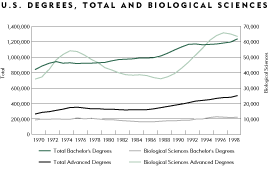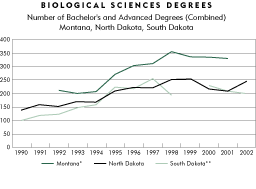Given the fickleness of measuring the biotech industry on the basis of firms, other science-based measures might be useful proxies for how well states are positioned in the fight to become a biotech or bioscience hub.
One possible gauge of the private biotech sector, with its research intensive, multidisciplinary nature, is to look at the number of research and development firms in engineering, and physical and life sciences. According to County Business Patterns (compiled by the U.S. Bureau of the Census), Minnesota heads the pack of district states with 178 such R&D firms as of 2001, followed by Wisconsin with 128, Montana with a surprising 53, North Dakota (20) and South Dakota (17).
But that's only part of the picture. The vast majority of these firms employ only a few people in an office or lab; of the 396 such firms in the five district states, 60 percent (236) had fewer than five employees, and only 25 firms had more than 50 employees. However, they appear to be ramping up; employment among these firms in both Minnesota and Wisconsin increased at least 50 percent from 1998 to 2002, adding 1,000 jobs each.
It's also useful to look at the number of private-sector scientists, including disciplines that would intersect bioscience applications. The problem is that there is no category for scientists in biotech or bioscience. Take a look at the number of life and physical scientists, along with a subjective list of related fields, mostly biomedical, chemical, material and environmental engineers. Growth in most district states appears to have been as strong or stronger than the national average. But the data is spotty enough that it's a hard measure to put much faith in.
But looking at the private sector, whether firms or employees, is something of a finished product in terms of economic development. There are other measures, like research funding and biological degrees conferred, that allow us to peek at the biotech assembly line.
Most university science research funding comes from federal sources, specifically the National Institutes of Health (NIH) and National Science Foundation (NSF). Though neither organization has a biotech funding category, NIH funding goes entirely toward biological sciences, and NSF has a similar, though comparatively small, category.
Nationwide, NIH funding soared 128 percent from 1992 to 2002, to $19 billion. All district states saw increases in funding, led in dollar terms by Minnesota, which doubled its NIH funding to $351 million from 1992 to 2002; Wisconsin's growth rate over the period was higher (at 119 percent) but overall funding was lower ($316 million) compared with its westerly neighbor. Montana quintupled its NIH funding to more than $25 million, while the growth rate during this period in both Dakotas was higher still, with each state pulling about $13 million in 2002.
NSF funding tells a different, if smaller, story. Nationwide, NSF funding in its biological sciences sector increased almost 70 percent from 1996 to 2002. Minnesota's tally zigzagged up a bit for several years, but actually saw a small funding decrease from 1996 to 2002 to $6.5 million. NSF biological funding was also stagnant in the Dakotas. Meanwhile, Wisconsin's take rose about 85 percent to $12 million, and Montana almost quintupled its funding over this period to $3 million in 2002.
Biological science degrees are also a way to determine if district states are generating the workers necessary to sustain a bio-economy. Nationwide, the number of degrees in biological sciences has seen something of a boom-and-bust cycle (see top chart). The 1990s saw a boom, with the number of annual degrees (bachelor's, master's, Ph.D.) rising from about 45,000 in 1990 to 73,000 in 2000, an increase of 62 percent, though the number has tailed off recently.
A similar growth trend has occurred in district states. South Dakota outperformed the nation in terms of biological science degrees, more than doubling its output from 1990 to 2000, though it also saw lower numbers in the subsequent two years and has the smallest pool of such graduates in the district. North Dakota saw an increase of 79 percent from 1990 to 2002, while Minnesota followed at 72 percent during this period. Though same-year data were not available, Montana and Wisconsin also had increases of more than 50 percent over a slightly shorter time frame.

Source: U.S. Department of Education

* Montana data missing for years 1990, 1991 and 2003
** South Dakota data missing for 1999
Source: State higher education offices and the
Integrated Post Secondary Education Data System

* Minnesota data missing for 1999
** Wisconsin data missing for 1990
Minnesota degrees conferred includes all public and private institutions.
Wisconsin degrees conferred includes only
institutions in the University of Wisconsin System.
Sources: State higher education offices and the
Integrated Post Secondary Education Data System
Public Affairs intern Marissa Benson provided research assistance.
Ron Wirtz is a Minneapolis Fed regional outreach director. Ron tracks current business conditions, with a focus on employment and wages, construction, real estate, consumer spending, and tourism. In this role, he networks with businesses in the Bank’s six-state region and gives frequent speeches on economic conditions. Follow him on Twitter @RonWirtz.





